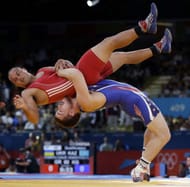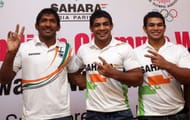Wrestling is one of the oldest hand-to-hand close combat sports in the history of the world. It has been in existence since ancient times of the Greek and the Romans and continues to ride the waves of popularity even to this day.
Being such an old event has its pros and cons.
The pros include the facts that the basic structure of the game has not deviated from the original, keeping it as simple as possible and the one-word ‘wrestling” still manages to give a quick-recall of the sport to the general public.
The cons are mainly due to the fact that the small changes made to the sport over time along its long history have resulted in its fractioning into at least six distinct branches, each with its own unique style and rules. Although all of them are referred to, under the umbrella term ‘Wrestling’, each has its own proponents and only two of these styles make it to the Olympic Stage:
1) Greco-Roman Style
2) Freestyle Wrestling
Objective
The initial conditions of the match start with the two participants diametrically opposite, facing each other one meter apart. The mat itself is a thick rubber area that is shock-absorbent in nature for safety reasons and has to be new for all major competitions (regulations).
The main wrestling area is 9m in diameter with a 1.5m wide circle around it, known as the Protection Zone. Inside the main wrestling area is a 1m wide patch called the Red Zone to indicate ‘passivity’ of the participants. The central wrestling area is 7m in diameter and a further 1m diameter circle inside, represents the central circle.The central circle is further surrounded by a 10cm patch which is cut in half by an 8cm wide line.
The main objective is to pin the opponent to the ground, which is achieved by holding his/her shoulder blades to the mat for a couple seconds or so. Also called a ‘fall’, a pin ends the match automatically. A win without a pin must involve the winning wrestler accumulating more regulation point—through legal moves or techniques—than the opponent.
Although the rules for the two styles of wrestling are virtually identical, the Greco-Roman style differs from Freestyle wrestling in that the players cannot attack their opponent anywhere below the waist to execute moves or trip them. In Freestyle, the use of both arms and legs are legally allowed.
This is why a particular move called a ‘suplex’ has great prominence in the Greco-Roman style, in which the offensive wrestler lifts his opponent in the air and swings him in a high arch while falling backwards on his own neck in order to bring his opponent's shoulders down to the mat. Other popular moves include the headlock, bear hug, arm drag etc.
Format
The two styles typically consist of three two-minute sessions and are scored under regulation unless a player wins by a pin. Otherwise, the scores for the two rounds are taken on a ‘two-best-out-of-three’ format. A technical fall is designed to have a threshold of 10-point lead in Freestyle wrestling and an 8-point lead in Greco-Roman Wrestling. These are some of the new changes made to ensure more audience enthusiasm and offensive tackling.
According to UWA(United World Wrestling), the highest governing body of the sport, the new weight classes for the Olympic Games are:
Men’s Freestyle (all weights in kilograms): 57, 65, 74, 86, 97, 125
Men’s Greco-Roman: 59, 66, 75, 85, 98, 130
Women’s Freestyle: 48, 53, 58, 63, 69, 75.
Passivity
Both participants are expected to give their maximum efforts. Any hint of unsporting behaviour results in a warning and eventual penalty. Passivity becomes obvious when a wrestler:
- fails to attempt or execute any holds.
- is content to neutralise the opposition’s holds or moves.
- does not try to initiate effective holds.
- purposefully flees the mat, ‘plays the edge’ or avoids wrestling by pushing the opposition away
- prevents the opposition from wrestling
- fakes head throws again and again; slips off; falls to the mat on purpose and lies there; locks legs around the opposition’s leg.
- in Greco-Roman wrestling, engages in combat with head thrust forward preventing bodily contact.
Cautions
Cautions are penalties imposed on a player under the following circumstances:
- if a player flees the mat
- if a player flees a hold
- if a player refuses to start
- if a player performs an illegal or brutal hold
Illegal holds
Punishing or brutal holds are not legal as they can result in severe injuries. They include choking, twisting of digits; striking the opponent with an elbow/knee, head butting, hair pulling, pinching, and/or biting. Some specific holds and/or moves on the head, arms or legs are banned because of extreme danger to the vertebrae and joints.
Headlocks without an arm included to bring an opponent's arm behind his or her back at an acute angle (also called a hammerlock) are also prohibited, a move that applies severe pressure to the neck or spine. The most dangerous hold is driving the opponent head first into the mat from standing position which can cause severe trauma to the cranium and neck.
In freestyle wrestling, the leg scissors hold with the feet crossed may not be applied to the head, neck or body, although it may be used on an opponent's limbs. In Greco-Roman of course, any use of the legs is illegal. These are however some of the most common violations in the Greco-Roman Style.
Awarding of Points
Takedown (Worth 1 to 5 Points) – When a wrestler gains control over the opponent from a neutral position with at least 3 points of contact to the mat.
- 5 Points – awarded for the execution of a takedown either from the standing or the par terre position into a direct or dangerous position
- 3 Points – awarded in which the takedown does not bring the opposition to a position of immediate danger or when the opponent is taken from his feet/stomach to his back/side
- 1 Point – awarded for a takedown that takes the opponent to his back/side from his feet/stomach without exposing back/shoulders to the mat
Reversal (worth 1 Point) – awarded when control over the opponent is gained from a disadvantage or a defensive position
Exposure/Danger position (worth 2 or 3 Points) – Points are awarded for holding the back/shoulders of the opponent to the mat. This is awarded even if it’s not a pin. An extra point is awarded for holding the position for 5 seconds or so
Penalty (worth 1 or 2 points) – Awarded to the opponent in case of a caution
Out-of-bounds (worth 1 point) – Awarded to the opponent if a wrestler steps into the protection zone
Tournament Structure
The first round is the Qualification round. If an excess of an ideal number (4,8,16,32 etc) say 22 wrestlers participate in an event, the players have to draw numbers randomly. The wrestlers who picked up the 6 highest numbers and the 6 wrestlers immediately above 17 play against each other to decide the final 16.
This is followed by the Elimination Round. In the elimination round, the wrestlers are pair off against each other and compete in matches until two finalists emerge victorious. Every wrestler who lost to the two finalists then have the chance to advance further in a repechage round. This feature makes the tournament structure of wrestling one of the fairest among all sports.
The repechage round starts with the wrestlers who lost to the two finalists at the lowest level of competition in the elimination round. The matches are paired off against the wrestlers who lost to one finalist and the wrestlers who lost to the other. The two wrestlers who win after every level of competition are the victors of the repechage round and awarded third and fourth place respectively.
In the finals, the two victors of the elimination round compete for the Gold and Silver respectively.
The Indian contingent for the 2016 Rio Olympics features eight wrestlers and there are high hopes for a few medals being bagged by these athletes. Here is the entire list of Indian Wrestlers gunning for gold.
Men
1) Yogeshwar Dutt (Freestyle 65 kg)
2) Narsingh Pancham Yadav (Freestyle 74 kg)
3) Sandeep Tomar (Freestyle 57 kg)
4) Hardeep Singh (Greco-Roman 98 kg)
5) Ravinder Khatri (Greco-Roman 85 kg)
Women
1) Sakshi Malik (Freestyle 58 kg)
2) Vinesh Phogat (Freestyle 48 Kg)
3) Babita Kumari (Freestyle 53 kg)


